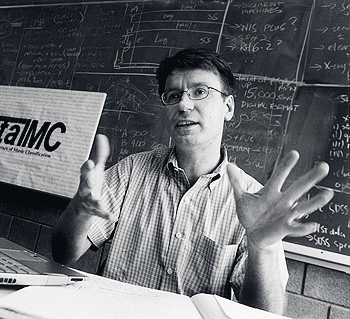Science Magazine said the work of a Carnegie Mellon astrophysicist contributed to discoveries that end a decades-long argument about the nature of the universe. The magazine called the accomplishment the No. 1 scientific breakthrough of 2003.

Professor Robert Nichol helped detect dark energy’s shadow on background radiation left over from the “Big Bang.” Nichol's said the work provides a new way of looking at the universe and may help determine the nature of dark energy, one of the greatest conundrums in science. Dark energy is believed to repulse rather than attract. This repulsion causes the universe’s expansion to accelerate, in contrast to the attraction of ordinary (and dark) matter, which would make the universe decelerate. The discovery led to an appearance by Nichol's on The Late Show With David Letterman, and coverage in the New York Times, New Scientist and other national media outlets. The Pittsburgh-based investigators, which included a team from the University of Pittsburgh and astronomers from the Sloan Digital Sky Survey, found an imprint of dark energy by correlating millions of galaxies in the Sloan Digital Sky Survey (SDSS) against the cosmic microwave background (CMB) temperature maps from NASA's Wilkinson Microwave Anisotropy Probe (WMAP).
The SDSS is mapping in detail one-quarter of the entire sky, determining the positions and brightness of 100 million celestial objects. It also is measuring the distances to more than a million galaxies and quasars. WMAP is a NASA mission to measure the temperature of the CMB, the remnant heat from the Big Bang. The mission is revealing conditions as they existed in the early universe by measuring the properties of the CMB over the full sky.
For more, visit: astrophysics.phys.cmu.edu/~nichol/ See Nichol’s appearance on The Late Show with David Letterman at astrophysics.phys.cmu.edu/~nichol/letterman/movies/



